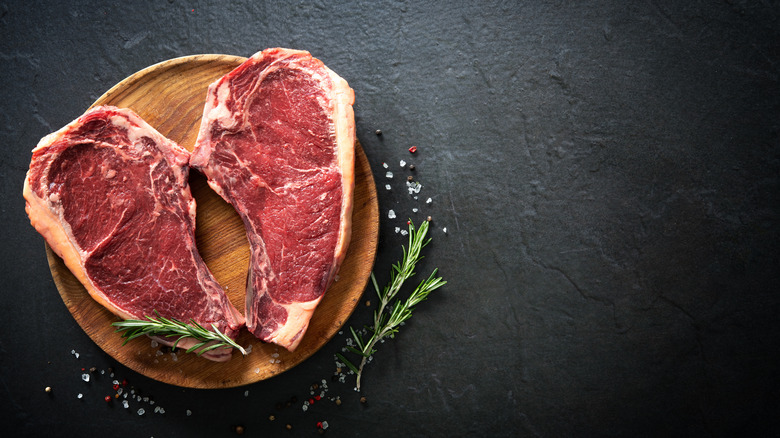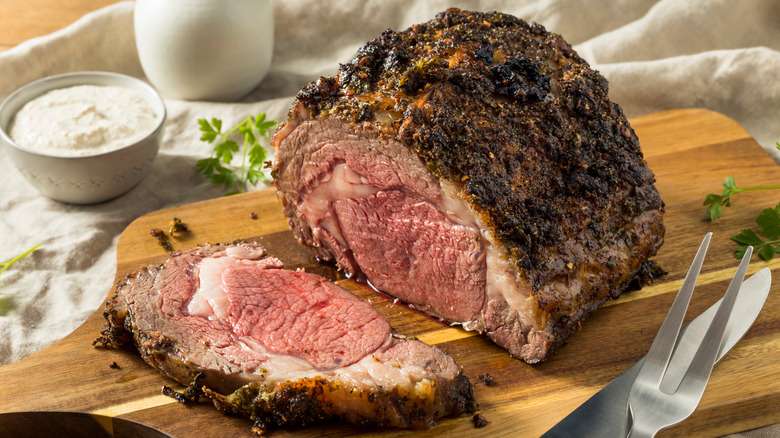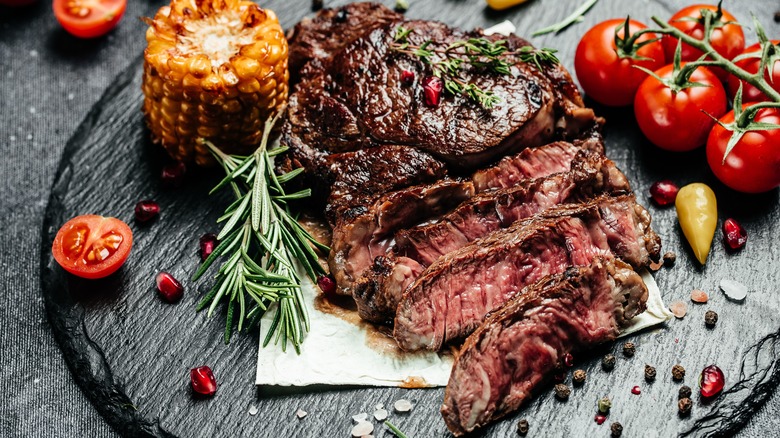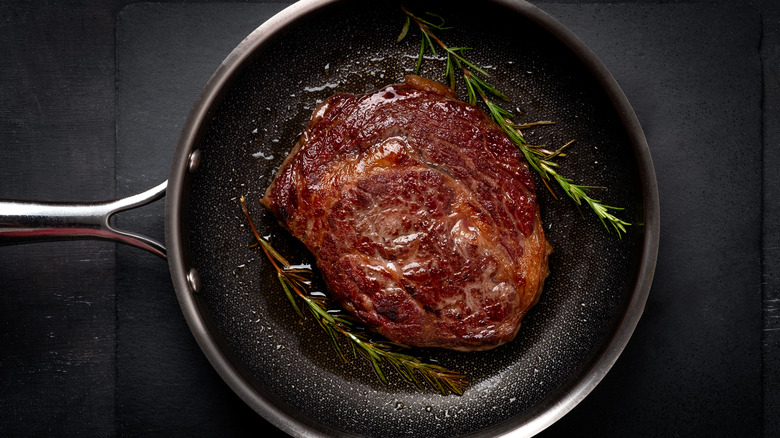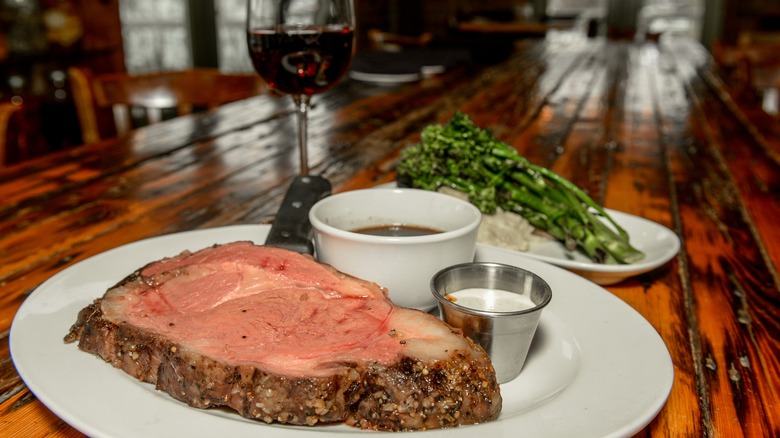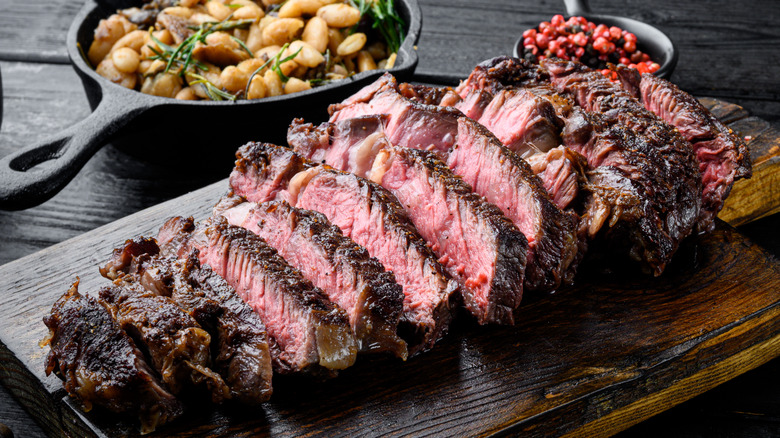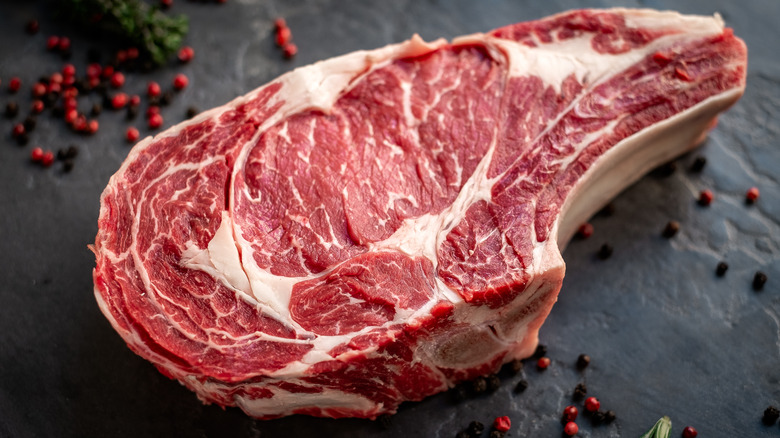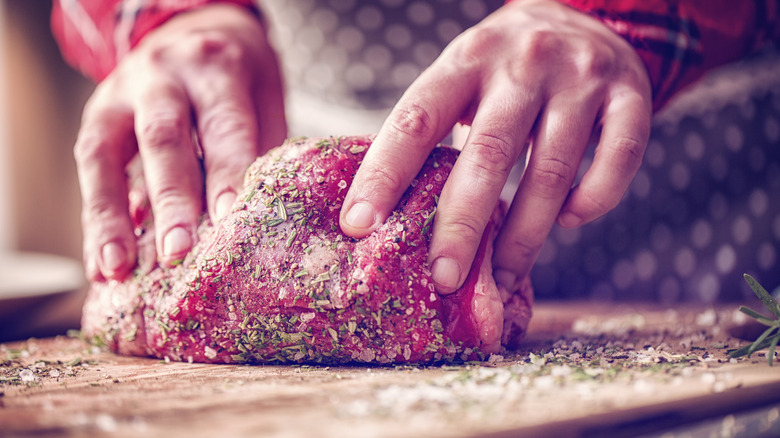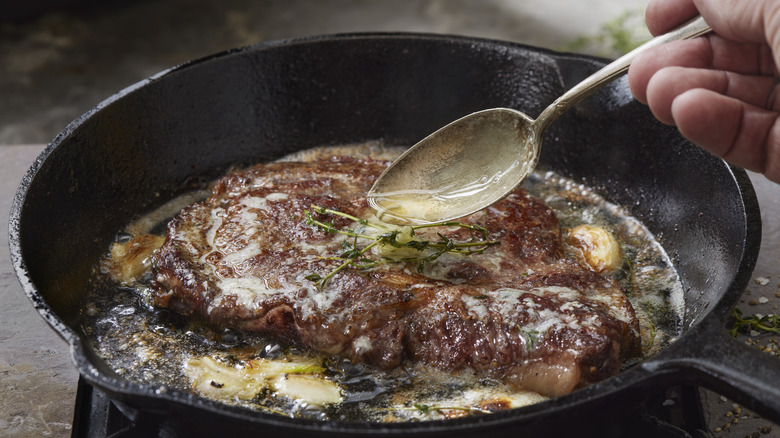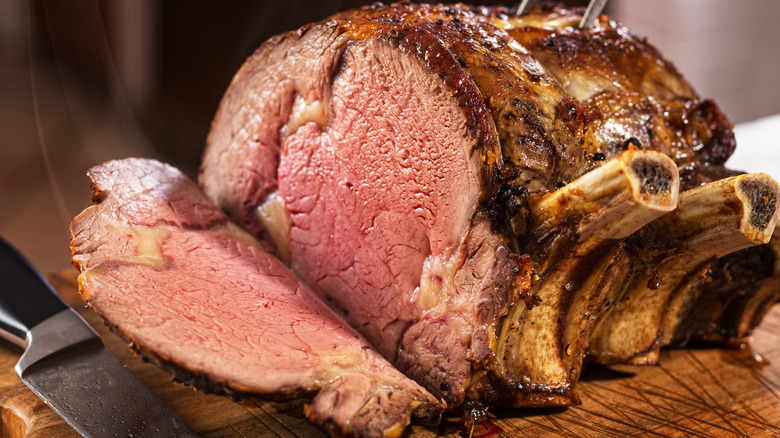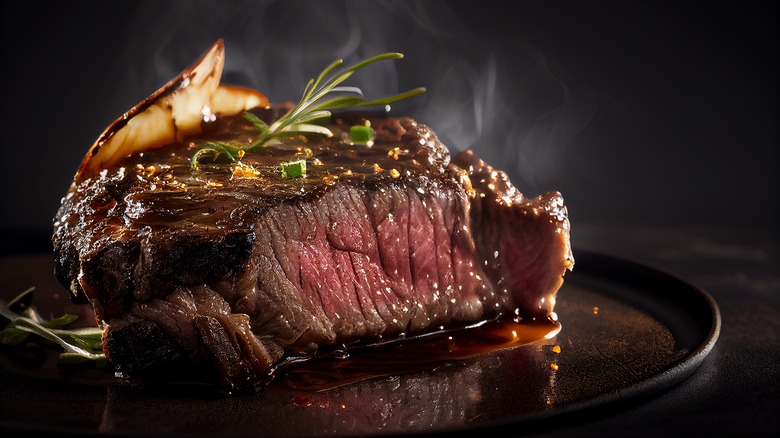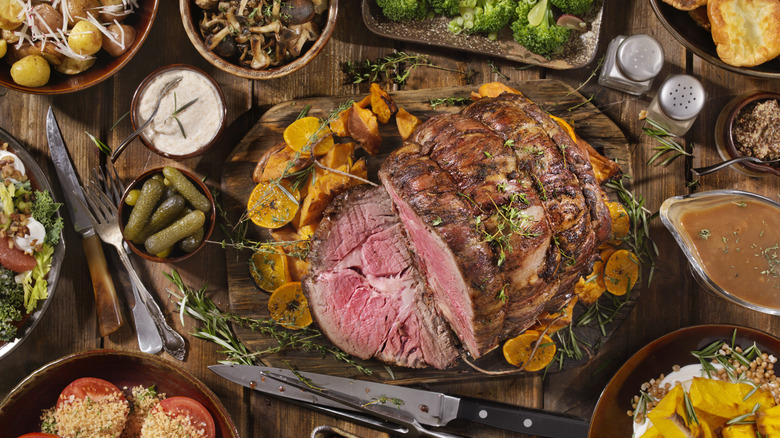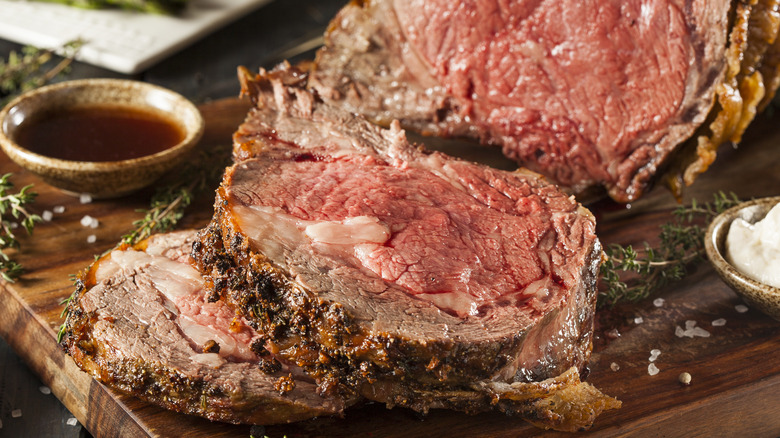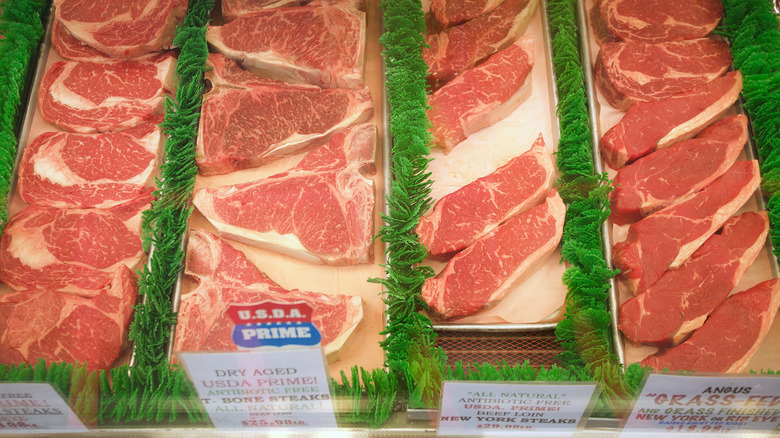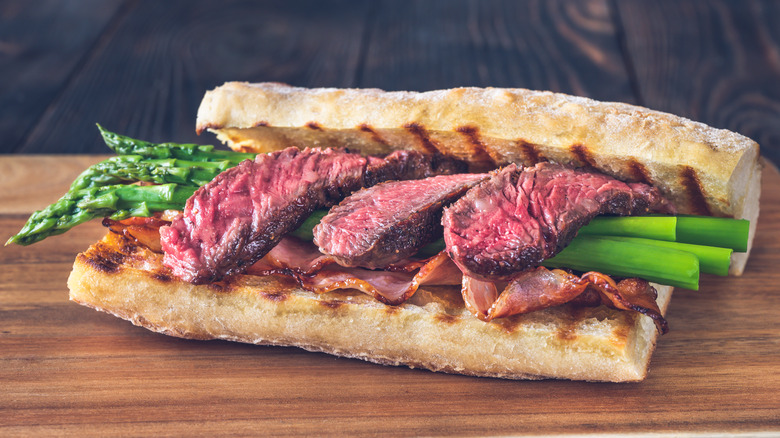Prime Rib Vs Ribeye: Everything You Need To Know
Prime rib and ribeye are two popular cuts of beef that grace the menus of steakhouses and dinner tables alike. While both come from the cow's rib section, they offer distinct culinary experiences. There are many differences in everything from taste to appearance, but prime rib is cut for a crowd, while ribeye is more for dining a deux.
Of course, prime rib and ribeye have a distinctly different vibe beyond just size, along with different accompaniments and proper cooking techniques. Both can be challenging to perfect, but in the end, you'll find it's a delicious experiment to get right.
Whether you're a die-hard fan of the rich and tender prime rib or prefer the bold and marbled ribeye, knowing the differences between the cuts broadens your culinary horizons and equips you with the knowledge to appreciate the unique qualities of each cut. Best of all, this means you can make the most delicious decision for your palate and your purposes.
What is prime rib?
The rib is a primal cut of beef, one of the first pieces removed from an animal during butchering. The other seven primal cuts include loin, flank, round, short plate, shank, brisket, and chuck. Prime rib is a sub-primal cut that contains several of those ribs, often three or more, and is roasted whole or as a standing rib roast. It is a highly flavorful cut that has quite a bit of fat. This fat renders down during cooking to produce a juicy, tender serving that is sliced to order. Prime rib is often hailed as the king of cuts, boasting a melt-in-your-mouth tenderness and an indulgent richness.
You may know prime rib as the meat served at a buffet line carving station, and there's a good reason for that. Prime rib can serve a larger number of people, with some margin of error for different preferences for doneness. The ends will likely be slightly more done than the center of the meat, but it can be a subtle difference. Prime rib is a great holiday roast that stays juicy and delicious even when it sits at room temperature for a long period.
What is ribeye?
In an interesting twist, ribeye is actually found in the prime rib. That means all prime rib has the potential to make ribeye. Both cuts come from the same area of the cow, but a ribeye is a smaller portion sliced away from the prime rib. If prime rib is the primal cut, ribeye is considered a sub-primal cut. As with prime rib, this cut has plenty of fat to keep it flavorful, and even the simplest ribeye recipes will draw attention to the big beefy flavor. Overall, it's a great cut for those who appreciate a more pronounced taste.
The most tender and delicious part of a ribeye is the rib cap. It is a delicate piece of beef that's separated from the rest of the steak by a thin but obvious line of fat. Some butchers or specialty shops remove the rib cap and sell it on its own, but why not reap the benefits of the entire cut and save this sought-after morsel as the delicious finale of your dinner?
Preparation of prime rib and ribeye
There are various ways to prepare both of these steaks. Ribeye, a cut best served medium rare, is best prepared in a more hands-on manner. This might mean searing the steak in a cast iron pan and finishing it in the oven, or basting it to perfection in a quality nonstick skillet. There's also the reverse sear, a sous vide-inspired method that involves cooking the steak in an oven or grill set to a lower temperature and then searing the meat just before bringing it to the table. However, if you want the method that'll give you the most accurate and consistent temperature on your ribeye, go with sous vide.
Prime rib, on the other hand, requires more time and tends to do better with low-temperature cooking, so the oven is typically the most popular choice. This renders the copious fat and keeps the meat tender. Since this is one big piece of meat that will later get sliced and served, it may not be the choice if you're serving guests who all want their meat cooked to different temperatures. You can use a sous vide machine or slow cooker, but only if you plan well ahead so that you can add some color by finishing it in the oven or on the stove.
Flavor
Both prime rib and ribeye are packed with flavor, a nod to the ample fat that stripes each cut. Prime rib and bone-in ribeye are slightly more flavorful thanks to the presence of bones, which lend a rich meatiness that boneless steak lacks. Some steak aficionados argue that prime rib, with its longer cooking time, larger muscle, increased fat, and multiple bones, has the deepest flavor. But for those who crave ribeye, a delicious steak is just minutes away, and that speedy preparation is a proper trade-off for the minuscule diminution of flavor that might occur.
Even boneless ribeye has a delicious, savory flavor, and all types of ribeye and prime rib can be enhanced by the proper cooking technique. A slow and low approach allows the fat to render slowly, basting the meat and infusing it with a luscious taste and melting mouthfeel. Adding the proper amount of seasoning bumps up the flavor quotient further and can turn even a lackluster cut of meat into something delicious.
Texture
Again, because both cuts are from the same area of the cow, the muscle and fat that make up the taste and texture of both ribeye and prime rib are remarkably similar. Holding a raw sample of either in your hand, the only thing to help you see the difference will likely be the weight of a prime rib versus a single ribeye steak.
However, once you cook each of these cuts, the difference in texture becomes more apparent. The most popular method of cooking ribeye — a hard sear followed either by butter basting or finishing in the oven — produces a chewy, somewhat crunchy texture upon the first bite, followed by a tender but toothsome interior.
On the other hand, the generous amount of time prime rib spends in the oven, slow cooker, or sous vide means there is less bite to the exterior — diners skip right to the part where the meat melts across the tongue. You can, of course, add more texture and color to the prime rib's exterior by finishing it under a broiler, as you're not looking for a bland, slightly grey finish.
Fat content
Fat content, or marbling, has a lot to do with both the taste and texture of both prime rib and ribeye. Their marbling patterns are similar because these two cuts come from the same part of the cow. However, because it's larger, prime rib has more fat running through it. When cooked slowly, this larger piece of meat has the benefit of that copious marbling breaking down and suffusing a delicious beefy flavor throughout.
However, the particular prime rib you choose affects the amount of fat it contains. The chuck end of prime rib includes ribs six through nine of the cow, while the loin end has ribs 10 through 12. Ribs 10 through 12 (the first cut) are leaner but still tender, but the chuck end is packed with juicy fat. If you slice a ribeye out of a prime rib, the fat content similarly fluctuates depending on where you're getting the steak.
Seasoning prime rib vs ribeye
Underseasoning steak is a common mistake for those who are new to cooking beef of any kind, so the first thing to know is that both of these cuts require a generous amount of coarse salt. Both prime rib and ribeye require almost a teaspoon per pound of meat before adding any other seasoning. Salting your steak well before it's time to cook draws out excess moisture to create a brine that the steak then reabsorbs. This begins to tenderize the flesh, making for a far better final result.
For ribeye, add some pepper — plus garlic and woody herbs like rosemary in your basting or finishing butter — and you're all set. After the salt shaker does its work, prime rib loves a healthy dose of herbs and spices as well. Everything from chili powder to cumin to onion powder works well to add flavor and depth to prime rib's already powerful taste. It's really up to personal preference and what else will be served.
Bring both prime rib and ribeye to room temperature before seasoning them; both can be salted and left to rest the night before in the fridge. Roll your prime rib in the seasoning blend of your choice, then bring both cuts to room temperature before cooking.
Cooking method
When it comes to cooking, it's not surprising that ribeye and prime rib have some similarities. They can both be grilled, cooked sous vide, or pan-seared and finished in the oven (or the other way around). The techniques for these are slightly different, and because of the size of each cut, cooking times will vary. If you want to pan-sear a ribeye and then butter-baste it or finish in the oven, you'll need the center to reach a temperature of 125 degrees Fahrenheit for rare and up to 165 for well-done. The time to finish ranges from 8 minutes to 16 minutes, which is much faster than prime rib, which can vary by quite a bit — for example, it can take 15-35 minutes per pound for medium-rare, depending on what temperature your oven is.
Perhaps the best way to cook prime rib is to roast it slow and low for a long time until it's near the temperature you want. In the last few moments, turn up the heat to caramelize the outside. This is also a great way to multitask a large dinner, since sides can be prepared while the prime rib roasts.
For both prime rib and ribeye, make sure you bring both to room temperature before cooking. Cooking cold meat is a major steak mistake that can lead to uneven cooking. Regardless of what other spices or herbs you use, season both with plenty of salt for the best flavor.
Cost
Neither of these cuts of beef is budget-friendly. They are meant to be served in celebration and for those times when a little extra special meal is called for. However, the price can differ depending on the cut and where you purchase your beef. In general, butcher shops and specialty stores have higher prices than standard supermarkets. A butcher shop or specialty store often cuts its prime rib and ribeye on the premises, whereas a supermarket gets shrink-wrapped beef shipped from a main warehouse. The volume allows supermarkets to keep prices lower.
If you want to trim the fat in your budget, avoid boneless ribeye. Boneless cuts require more time and attention to remove the bone, which is reflected in their price. In some cases, prime rib can be the more affordable per-pound option. To keep costs low, purchase only the amount of prime rib you need (about 1 pound per person). It is always nice to have leftovers, but a smaller prime rib means a lower price tag.
Use
Both of these luxurious cuts are perfect for special celebrations. Their price and exceptional taste mean they're meant to be savored with family and friends on occasions that deserve to be marked.
Prime rib is generally sliced and served to order. Yes, it can be found on low-budget buffet lines, but when served at home, it is a mark of a host who wants their guests to feel welcomed and pampered. Prime rib is also often served as a high-end plated meal, carved at the tableside.
On the other hand, if your celebration is more intimate, marking an anniversary or leaning towards a proposal, ribeye is a good choice. The other positive aspect of ribeye is that it can be cooked to a particular preference. When it comes to prime rib, it's difficult to tailor the cooking temperature to each individual's tastes; some may find it too over- or undercooked for their taste. However, ribeye is cooked individually and can be timed so that rare and medium-well steaks come out simultaneously. It does take extra hands and equipment in the kitchen, so if you have time and guests who are willing to help out, ribeye is a good choice.
Accompaniments
Both prime rib and ribeye can be an event all on their own, taking up most of the plate and satisfying even the most persnickety of carnivores. However, the accompaniments for both vary slightly, though there is some delicious overlap. No matter what you serve, the sides should not overwhelm the steak but rather complement its rich, beefy flavor. Acid and a little bit of bitterness will help cut the richness and make the meal more balanced.
Traditional accompaniments to prime rib include horseradish sauce, au jus made with natural pan juices, Yorkshire pudding, and roasted vegetables. Roasted broccolini, Brussels sprouts with pomegranate arils, and anything else that's green and slightly acidic will also help to cut through the richness of this meat.
Ribeye steak is a classic of the steakhouse, and mashed potatoes are a natural pairing. Sautéed mushrooms, creamed spinach, or a simple salad make delicious partners as well. That's not all: Roasted Brussels sprouts are also welcome sides here, as are asparagus, mashed sweet potatoes, and bitter greens like mustard and kale, especially when prepared in a traditional southern way.
Presentation
Prime rib is a celebratory food, usually served as a large roast, with slices carved at the table. In some high-end restaurants, sides and accompanying sauces are also prepared tableside, and the steak is dressed and plated for each guest. When it comes to an important family dinner, this individual plating might not make sense. Instead, bring the awe-inspiring roast out to the table for everyone to see, then pass the family-style sides. Or treat your family like they're royalty and plate and serve from the kitchen. Ribeye steaks are necessarily divvied up right off the grill or out of the pan because they may be cooked to order. It's nice to add pan sauces or compound butter before serving, too.
It is important to note that ribeye steaks also have their place around a campfire or barbecue. They are a special, delicious cut of meat, but they don't need to be precious. Many a fine ribeye steak has been served on a doubled-up paper plate with baked beans and cornbread sides. This cowboy way of serving is home both on the range and in your backyard.
Different names and grades
Most meat counters will label their prime rib as such, but it may also be called rib roast or standing rib roast. Standing rib roast gets its name from the position it is placed in for roasting (standing on the ribs). Ribeye steak has more names, marketed as bone-in ribeye or boneless ribeye, as well as Spencer cut, beauty steak, Scotch fillet, or a Delmonico steak.
Regardless of the name, both cuts are graded. The United States Department of Agriculture (USDA) grades all cuts of meat based on their potential for tenderness, juiciness, and flavor. USDA Prime includes just the top 8% of all beef and features heavy marbling across the entire cut. USDA Choice does have some marbling and is a high-quality selection in many supermarkets. The final grading option, USDA Select, has less fat and is more likely to be tough or difficult to tenderize. Within the USDA Prime and USDA Choice grades, you can choose a chuck or loin end of prime rib, which also influences how tender and juicy your final dish will be.
Using leftovers
Ribeye leftovers are unlikely, but if you do have some, they're delicious in sandwiches and salads. They can be sliced across the grain, shingled over hearty bread or rustic greens like romaine, and topped or dressed with whatever you like. Only reheat your ribeye if you really feel you must, as the slices may overcook and become tough.
Leftovers for a large prime rib are more common, and there are a wide variety of uses for this tender morsel. Leftover prime rib can be sliced thin and used for sandwiches in the same way that ribeye steak is. It can also be reheated and paired with mashed potatoes and gravy or added to weeknight casseroles like beef stroganoff.
When reheating either ribeye or prime rib, take care not to overcook or dry out this delicious cut of meat. The best way to heat either is to add a little liquid to whatever heating method you choose. For example, if you want to reheat prime rib in the oven, add your sliced prime rib and some beef stock to a baking dish and cover with aluminum foil. Reheat gently at no more than 250 degrees Fahrenheit until just warm. You can, of course, use a microwave, but tread lightly. Microwaves sap foods of their moisture quickly. Reheat in 30-second bursts in a microwave-safe bowl that is covered and has a bit of liquid in it.

